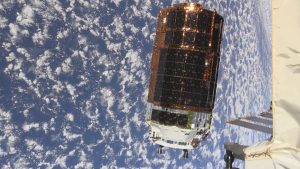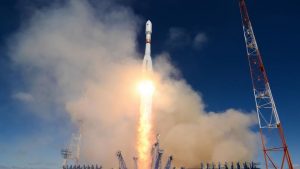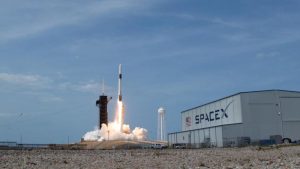Media
Transcript

A JAXA H-2B rocket launched the HTV-9 mission (aka Kounotori 9) on Wednesday, May 20, 2020, at 5:31 PM (UTC).
The mission patch is a gold ring around a blue and yellow graphic of the HTV capsule with a yellow image of the ISS in the distance against a black background. The text “H-II Transfer Vehicle” and mission designation “HTV9” are in the yellow ring. The Japanese characters (こうのとり9号機) say “Kounotori 9”.
It was a 2-stage rocket with liquid fuel for the stages and solid fuel for the boosters. The fuel consisted of oxygen and hydrogen.
This was the last H-2B; the first flight of the new H3 is planned for later this year. This was also the last Kounotori. A new Japanese cargo vessel is expected to launch in 2022.
A lot of cargo went to the ISS on HTV-9 — 6200 kilograms to be exact (4300 kg in the pressurized compartment and 1900 kg in the unpressurized compartment) — including a solid combustion experimental module; the module will continue research on combustion in microgravity. Also on board were 6 new lithium-ion batteries for the space station and fresh bell peppers, kiwi, and citrus fruits for the crew.
One of the other experiments was a Wireless LAN Demonstration, or WLD (pronounced wild). WLD was an experiment that was performed during Kounotori 9’s flight. During the test, a video taken by Kounotori 9 was broadcast in real-time onboard the space station, via a wireless LAN (WLAN) datalink. The experiment was conducted during Kounotori 9’s approach, departure, and while berthed to the ISS. For WLD, the spacecraft has a camera attached to its propulsion module, while a data processor and WLAN antenna is located at the Unpressurized Logistics Carrier’s aperture. The technology tested by WLD will enable ISS crews to monitor approaching vehicles during an autonomous docking. This will be the first time for two spacecraft to communicate using WLAN during a rendezvous.

On May 22 at 7:31 AM UTC, the Russian Armed Forces launched a Soyuz-2.1b rocket with the Kosmos 2546 mission. This was a military mission so details are a little scarce.
Here’s what we know: the payload was the Tundra 14L satellite that will be used for an early warning system, replacing the aging US-K and US-KMO constellations. This is the fourth satellite in the newer Tundra constellation.
The satellite was placed in a Molniya orbit, which is highly elliptical and highly inclined. When I say elliptical I don’t mean a tiny bit egg-shaped: we’re straight into “severely stretched” territory, with altitudes ranging from 600 to nearly 40,000 km above Earth! Take that long oval of an orbit and place it at a 63-degree angle relative to Earth’s equator, and you get the highly inclined orbit. So, what’s the purpose of this odd orbit?
Thanks to orbital mechanics, a Molniya orbit is uniquely suited to providing useful satellite coverage for Earth observation and communications services needed by ground terminals operating in high northern latitudes. Those areas are not easily serviceable from satellites in the typical geosynchronous orbits over the equator because any antenna you’re using would be pointing at such a low angle that a small hill could easily block the path of the signal. And even though polar-orbiting satellites can see these same latitudes, they only have coverage of any given spot for several minutes at a time. The Molniya orbit is inclined in such a way that the desired areas are not only clearly visible, but the satellite is also able to “pause” for a time at its highest point thanks to orbital mechanics, which provides several hours of uninterrupted coverage that LEO and GEO satellites simply can’t match.

Under development by Virgin Orbit since 2007, LauncherOne is an air-launched rocket for small satellite payloads. The launch date was Monday, May 25, 2020, at 7:50 PM (UTC).
Unlike other companies, Virgin Orbit uses a heavily modified 747 named Cosmic Girl as the launch platform for its rockets. Basically, they attach their rocket to the belly of Cosmic Girl, fly out over the ocean in a racetrack pattern, and at the appropriate time, release the rocket. A few seconds later, the engine on the rocket ignites, and off it goes.
All of the prelaunch activities – the trip to the test area, the final countdown, and the release – worked perfectly. They had a clean release, and LauncherOne successfully ignited its booster engine, a first for Virgin Orbit.
Shortly after ignition, there was an anomaly in the first stage of flight and the mission was aborted. Cosmic Girl and its crew returned to the Mojave Air and Space Port without further incident.
While they didn’t make it to orbit, Virgin Orbit is still very happy with the test because they were able to gather data on how the first stage performed, the aerodynamics, and their control algorithms, which will allow them to make changes before their next test.
Their next rocket is almost finished being constructed and there’s another six for follow-on missions. They’ve got all of these rockets being built at the same time to allow them to do a number of tests in rapid succession.

A China Long March 11 rocket launched the XJS-G, XJS-H mission on Friday, May 29, 2020, at 8:13 PM (UTC).
The payload for this mission is SUUUUUUUUPER SECRET. No, seriously, there’s not a lot of other information about this launch. What we do know is that two technology demonstration satellites were carried into low Earth orbit. While not much is known about the specific operations of these spacecraft, CASC reports that they will mainly focus on testing new Earth observation technologies, as well as inter-satellite communications between the members of the constellation.
This was the first launch from Xichang for the solid-fuel Long March 11.

After years of development and a single weather-related delay, on May 30, 2020, at 1922 UTC, Space X launched a Dragon Crew Capsule atop a Falcon 9 rocket with two humans on board: Doug Hurley and Bob Behnken. When they lit this candle up, they burned through 2 stages of highly refined kerosene-based RP-1* fuel and Liquid Oxygen.
After safely reaching orbit, Doug and Bob announced the final name of their capsule. From then on Demo-2 would be known as Endeavour. This name memorializes the Space Shuttle Endeavour, which was the first spacecraft both astronauts flew to orbit. The shuttle was named after the HMS Endeavour, which carried Captain James Cook on his first voyage of discovery in the late 1700s.
While everyone was captivated by the SpaceX space suits, and touch panels, the real star of the show was Tremor, an Apatosaurus plush made by Ty that had been selected from Bob and Doug’s kids’ toys to serve as a zero-g indicator. Exactly whose son’s toy was borrowed has not been revealed.
If the suits look like something out of a comic book, well, they could be. The suits were designed by Hollywood costume designer Jose Fernandez who has designed suits for Batman, X-Men United, and Fantastic Four.
Demo-2’s ultimate destination was the International Space Station, which it reached in just 19 hours.
Once onboard, Doug Hurley completed a multi-decade game of capture the flag and claimed a small US flag that was originally flown on STS-1 in 1981, and was left when he and his crewmates flew on STS-135. After that last shuttle flight, it was President Obama who said that Boeing and SpaceX would now be playing a game of capture the flag to bring that flag home. Doug had no idea back in 2011 that he would ever return to space, let alone return to it in such a historic way nine years later.
In addition to carrying Bob, Doug, and Tremor, Endeavour had a standard load of cargo that included basics like food.
While things generally went flawlessly with the Crew Dragon flight, the same can not be said with the last test firing of the SN4 Starship prototype. After successfully test-firing its engines, something went very wrong, and the vehicle and its surroundings were laid flat by a massive explosion. It’s unclear what happened at this stage, but multiple videos indicate the fire started near the base of the rocket, and it may not have been the rocket itself that started the explosion. While this loss of yet another prototype will slow SpaceX, it won’t slow them for long.
According to images coming from BocoChicaGal, SN5 and SN6 are already taking shape on the Texas coast.

Finally, a China Long March 2D rocket launched the Gaofen-9-02 mission on Sunday, May 31, 2020, at 8:53 AM (UTC).
The two-stage toxic nitrogen tetraoxide and unsymmetrical dimethylhydrazine fueled Long March 2D carried satellite Gaofen 9-02 to a sun-synchronous orbit, where it joined a constellation of similar satellites. It will be part of the state-sponsored program China High definition Earth Observation System (CHEOS). According to Xinhua News, Gaofen 9-02 is an optical remote sensing satellite with a ground pixel resolution up to sub-meter level, used for things such as urban planning, road network design, and disaster prevention.
Also, onboard the Long March 2D was HEAD 4, a 45 kg satellite developed by Beijing Hede Aerospace Technology Co. It will be used for global collection of ship navigation status, flight status, and Internet of Things information.

To wrap things up, here’s a running tally of a few spaceflight statistics for the current year:
Toilets currently in space: 4
Toilets burned up: 2
Total new satellites in orbit: 412 (includes those launched from other in-orbit craft, such as the ISS)
Total satellites from launches: 396
Total 2020 launch attempts: 39 (including 5 failures)
I keep track of orbital launches by where they launched from. Here’s that breakdown:
USA: 13
China: 12
Kazakhstan: 4
Russia: 3
French Guiana: 2
Iran: 2
Japan: 2
New Zealand: 1
Your useless space fact for the week comes to us from Carlos Alfaro, who shares that “[i]n 1963 about 480,000,000 copper dipole antennas (needles) were placed in orbit (between 3,500 and 3,800 km) to facilitate global radio communication. As of March 2020, 36 clumps of needles were still known to be in orbit.”
Learn More
Space Station Replenisher “Konotori” No. 9
Russia launches missile-watching satellite
- Russian Space Web article
- Tundra/EKS info page (Gunter’s Space Page)
Virgin Orbit Ignites LauncherOne Rocket During First Launch Demo, Mission Safely Terminated
A China Long March 11 rocket launched the XJS-G, XJS-H mission
- LaunchStuff Twitter thread
- XJS G info page (Gunter’s Space page)
- XJS H info page (Gunter’s Space page)
SpaceX Crew DEMO-2 Mission
- SpaceX mission update
- NASA Astronauts Launch from America in Historic Test Flight of SpaceX Crew Dragon (NASA)
SN4 Starships Suffers Catastrophic Explosion
- SpaceX’s Starship explosion explained by Elon Musk (Teslarati)
- SN4, We Hardly Knew You. Another Starship Prototype Lost! (Universe Today)
A China Long March 2D rocket launched the Gaofen-9-02 mission
- LaunchStuff Twitter thread
- Hede 1, 2A, 2B, 3, 4 info page (Gunter’s Space page)
- Gaofen 9-01, 02, 03 info page (Gunter’s Space page)
Credits
Host: Annie Wilson
Writers: Annie Wilson, Dave Ballard, Gordon Dewis, Ally Pelphrey
Audio and Video Editing: Ally Pelphrey
Content Editing by Beth Johnson
Executive Producer: Pamela Gay
Intro and Outro music by Kevin MacLeod, https://incompetech.com/music/


 We record most shows live, on Twitch. Follow us today to get alerts when we go live.
We record most shows live, on Twitch. Follow us today to get alerts when we go live.